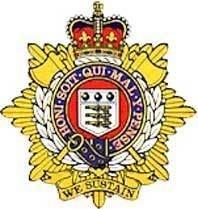The Royal Logistic Corps (RLC) provides logistic support functions to the British Army. It is the largest Corps in the Army. The RLC flag is dark blue with the Corps Badge emblazoned on the centre. It has a Corps of Drums and a "Marching" Band.
The Royal Logistic Corps (RLC) was formed on Monday, 5 April 1993, by the union of five British Army corps:
Royal Engineers Postal and Courier ServiceRoyal Corps of TransportRoyal Army Ordnance CorpsRoyal Pioneer CorpsArmy Catering CorpsThe RLC comprises both Regular and Army Reserve units.
The RLC is the only (Combat Service Support) Corps of the British Army with battle honours, derived from the usage of previous transport elements of the Royal Waggon Train, and their successors as cavalry. The battle honours are:
PeninsulaBattle of WaterlooLucknowTaku FortsPekingThe RLC cap badge is an amalgamation of the cap badges of the forming corps:
The laurel and garter band is from the Royal EngineersThe star is from the Royal Corps of TransportThe shield in the centre is from the Royal Army Ordnance CorpsThe crossed axes are from the Royal Pioneer CorpsThe motto, "We Sustain", is from the Army Catering CorpsThe inscription on the garter band "Honi soit qui mal y pense" can be translated as "Evil to him who evil thinks". It is often seen on the insignia of Regiments and Corps with 'Royal' in their title.
RLC units include:
RHQ The RLC. located at the "Home of the Corps", Princess Royal Barracks, Deepcut. Headed by Col RLC.Defence Explosive Ordnance Disposal, Munitions and Search School (DEMSS) formerly the Army School of Ammunition until 2009.15 Air Assault Close Support Squadron RLC (not mentioned in Army 2020). Attached to 13 Air Assault Support Regiment.ARRC Support Battalion (an All Arms unit with logistic squadrons making up the bulk of the battalion)Notable minor units and joint units with a large RLC element include:
20 Logistic Support Squadron, London District89 Postal and Courier Unit, (SHAPE)105 Logistic Support Squadron, (BATUS)132 Aviation Supply Squadron, part of 7 Battalion REME within 16 Air Assault BrigadeCyprus Service Support Unit, (British Forces Cyprus)Joint Helicopter Support Squadron, RAF Benson, a combined RLC / RAF unit.Disbanded Units:
2 Logistic Support Regiment RLC , based at Gutersloh. Formally disbanded in July 2014.8 Regiment - The Regiment formed in 1964 at Munster, Germany as 8 Transport Column, RASC at the height of the Cold War. Initially based in Nelson Barracks, it moved to Portsmouth Barracks and was disbanded in York Barracks on 27 March 2012. The regiment consisted of 3, 5, 13, 27 and 64 Squadrons and in its time had attached pioneers from the RPC, and infantry from a resident Munster battalion as Force Protection. It worked closely with the American Custodial Detachment whose role was maintenance of nuclear warheads and weapons components. The regiment directly supported the Gunners (The Royal Regiment of Artillery), firstly 24, 39 and 50 Missile Regiments and later the Multi-Launch Rocket System (MLRS) Regiments. This latter task was carried out in the UK from barracks at Catterick,1993-2008.12 Logistic Support Regiment - Disbanded at Abingdon 12 December 2013.19 Combat Service Support Battalion - a combined unit with a logistical squadron and an Equipment Support company. Disbanded N Ireland December 2012.23 Pioneer Regiment - a specialist pioneer unit with artisans, defence and Force Protection elements. Disbanded at Bicester November 2014.24 Regiment - disbanded in Germany, 30 January 2014. Part of 104th Logistic Support Brigade.Drivers, Technicians, EOD all selected from the RLC.
44 Support Squadron, (Royal Military Academy Sandhurst)2 Operational Support Group RLC150 Regiment151 Regiment152 (North Irish) Regiment154 (Scottish) Regiment156 Regiment157 (Welsh) Regiment158 Regiment159 Regiment162 Regiment165 Port and Maritime Regiment167 Catering Support Regiment383 Commando Petroleum Troop384 Commando Petroleum TroopFormer units
153 The Scottish Transport Regiment155 (Wessex) Transport Regiment160 Transport Regiment166 Supply RegimentThe Corps Headquarters is at Dettingen House within Princess Royal Barracks in Deepcut near Camberley, Surrey. It is headed by a Colonel (Colonel RLC) as the professional head of the Corps. Col RLC is responsible for the Moral Component, regimental infrastructure and support and works to the Adjutant General Col RLC remains responsible for the Corps of Drums, which often parades with the RLC Band. (AG).
There is also a ceremonial head (instituted in 2009), who heads the Corps and its wider family such as the Associations and Cadets, known as the Master General of Logistics (MGL). Holders of the post include:
General Sir Kevin O'Donoghue (2009-2012)Lieutenant General Mark Poffley (2012–present)The Sustainer is the magazine of the RLC Association. The Waggoner remains the Journal of the RASC/RCT Association. The RAOC Gazette that of the RAOC Association and the Pioneer of the RPC Association. The Review is an annual magazine of essays published by the Corps.
The RLC has five Victoria Cross holders; Five derive historically from establishments that eventually became the Royal Corps of Transport.
Private Samuel Morley VC. Military Train. 15 April 1858.Private (Farrier) Michael Murphy VC (forfeited and re-listed). Military Train. 15 April 1858.Assistant Commissary James Langley Dalton VC. Commissariat & Transport Department. 22 January 1879.Second Lieutenant Alfred Cecil Herring VC. Army Service Corps. 23 March 1918.Private Richard George Masters VC. Army Service Corps. 9 April 1918.
